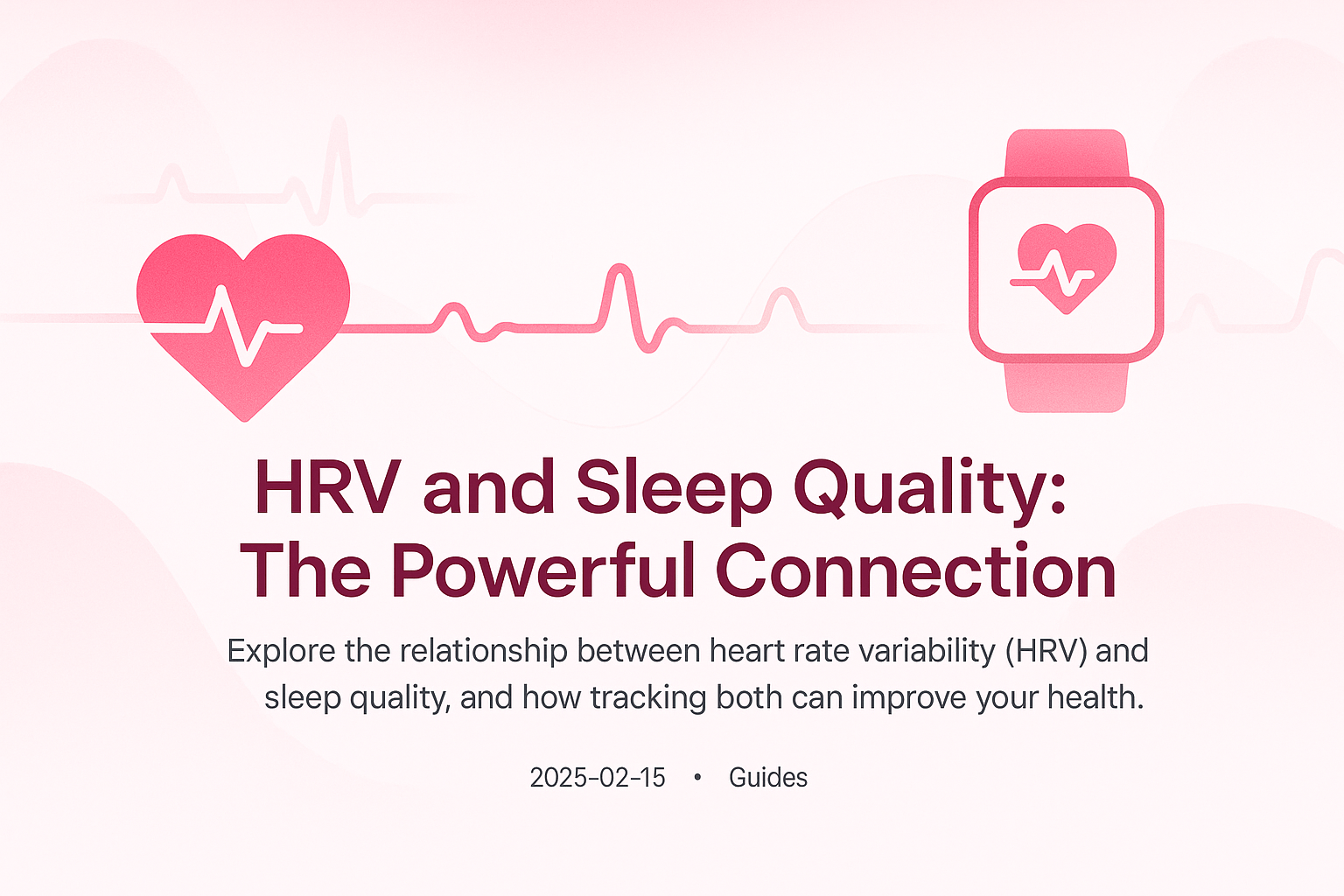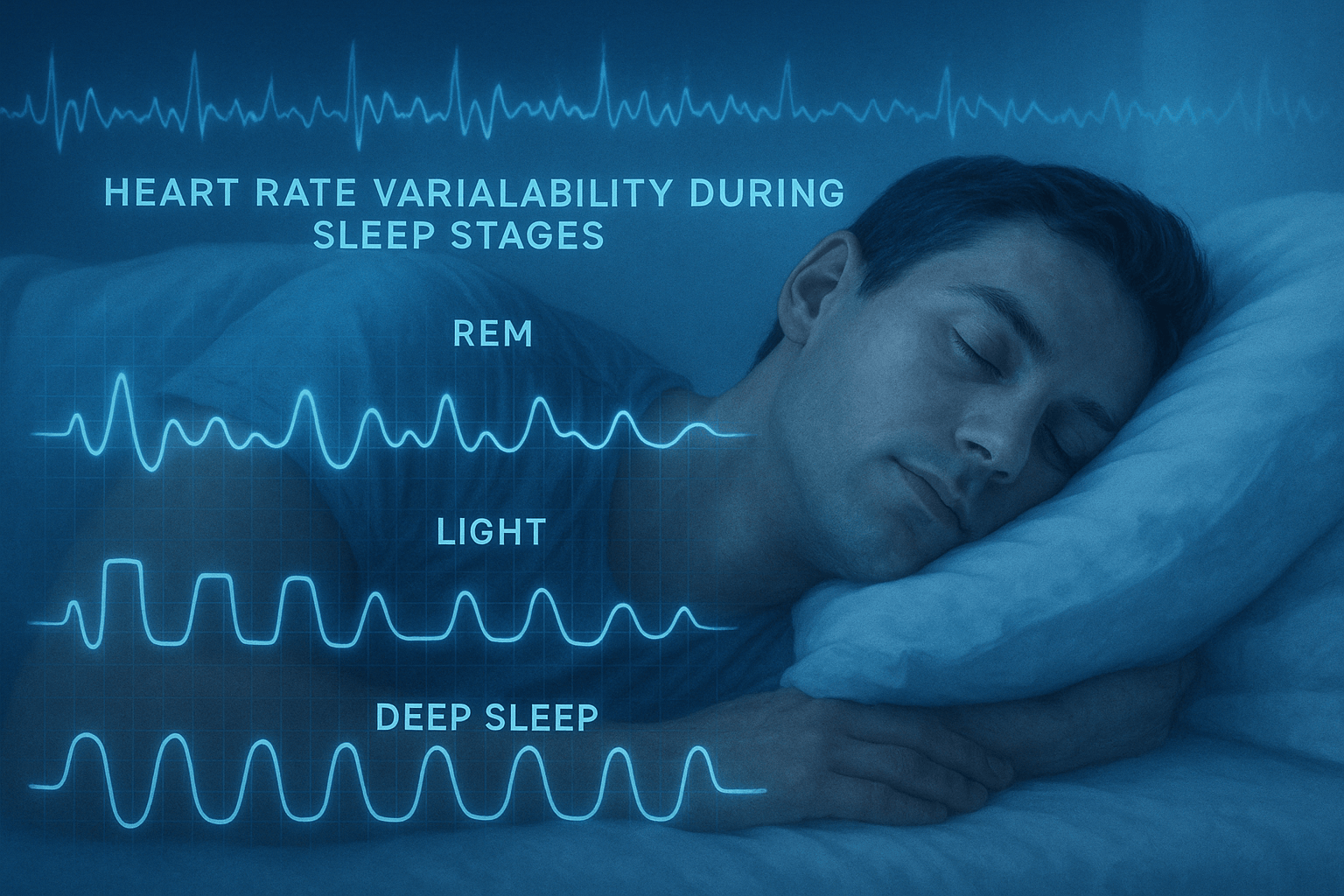HRV and Sleep Quality: The Powerful Connection

Ready to start tracking your HRV? Check out our top picks: Whoop | Oura Ring | Polar H10
HRV and Sleep Quality: The Powerful Connection
Sleep and recovery are fundamental to health and performance, yet they remain challenging to measure objectively. Heart Rate Variability (HRV) has emerged as one of the most valuable metrics for understanding sleep quality and its impact on overall health. This comprehensive guide explores the relationship between HRV and sleep, and how you can use this knowledge to improve both.
Understanding the HRV-Sleep Connection
How Sleep Affects HRV
Sleep is a time of parasympathetic dominance - your "rest and digest" system takes over, allowing your body to recover. This typically results in higher HRV during sleep, especially during deep sleep stages. However, several factors can disrupt this pattern:
- Sleep deprivation: Reduces overall HRV
- Poor sleep quality: Prevents the normal HRV increase during deep sleep
- Sleep disorders: Conditions like sleep apnea can cause abnormal HRV patterns
- Alcohol and certain medications: Can suppress HRV during sleep
How HRV Reflects Sleep Quality
Your nighttime and morning HRV measurements provide valuable insights into your sleep quality:
- High and stable nighttime HRV: Generally indicates good sleep quality and effective recovery
- Low or declining nighttime HRV: May indicate poor sleep quality or inadequate recovery
- Morning HRV below your baseline: Often suggests incomplete recovery, regardless of sleep duration

Measuring HRV During Sleep
The Best Devices for Sleep HRV Monitoring
Not all HRV monitors are created equal when it comes to sleep tracking. These devices excel at nighttime HRV monitoring:
-
- Extremely comfortable for sleep
- Provides detailed sleep stage analysis
- Tracks HRV throughout the night
- Offers a sleep score incorporating HRV data
-
- Comfortable strap design
- Detailed recovery metrics based on sleep HRV
- Sleep coaching features
- Tracks respiratory rate during sleep
-
Polar H10 (for spot checks):
- Not designed for continuous sleep monitoring
- Can be used for morning readiness assessments
- Provides highly accurate HRV measurements
Key HRV Metrics for Sleep Assessment
When analyzing your sleep HRV, pay attention to these metrics:
- Average nighttime HRV: Your overall HRV during sleep
- HRV during deep sleep: HRV typically peaks during deep sleep phases
- Morning HRV: Your HRV upon waking, often used as a recovery indicator
- HRV trends: Changes in your sleep HRV over time
Interpreting Your Sleep HRV Data
Establishing Your Baseline
To effectively use HRV for sleep optimization, establish your personal baseline:
- Track your sleep HRV consistently for 2-3 weeks
- Note your typical ranges during different sleep stages
- Identify your normal morning HRV values
- Observe how different factors affect your sleep HRV
Common Sleep HRV Patterns
Once you have a baseline, you can identify these common patterns:
- Optimal recovery: High, stable HRV during deep sleep with morning values at or above your baseline
- Incomplete recovery: Lower than normal HRV during deep sleep and below-baseline morning readings
- Disrupted sleep: Erratic HRV patterns throughout the night, often with multiple drops
- Overtraining pattern: Progressively declining morning HRV over several days
Factors That Affect Sleep HRV
Lifestyle Factors
Many daily choices significantly impact your sleep HRV:
- Alcohol consumption: Even moderate amounts can reduce nighttime HRV by 10-30%
- Late meals: Eating within 2-3 hours of bedtime often reduces sleep HRV
- Screen exposure: Blue light before bed can disrupt sleep HRV patterns
- Exercise timing: Intense exercise too close to bedtime may lower sleep HRV
- Stress levels: High stress during the day often carries over into reduced sleep HRV
Environmental Factors
Your sleep environment plays a crucial role in optimizing sleep HRV:
- Temperature: Sleeping in a cool room (65-68°F/18-20°C) typically improves HRV
- Light exposure: Complete darkness promotes better sleep HRV
- Noise: Even subconscious noise disruptions can cause HRV drops during sleep
- Electromagnetic fields: Some evidence suggests EMFs may affect sleep HRV

Evidence-Based Strategies to Improve Sleep HRV
Sleep Hygiene Practices
These fundamental practices can significantly improve your sleep HRV:
- Consistent schedule: Go to bed and wake up at the same times
- Sleep environment: Keep your bedroom cool, dark, and quiet
- Wind-down routine: Implement a 30-60 minute pre-sleep ritual
- Limit stimulants: Avoid caffeine after midday
- Digital sunset: Reduce blue light exposure 1-2 hours before bed
Research highlight: A study in Sleep Medicine found that implementing basic sleep hygiene practices improved HRV parameters during sleep by an average of 15%.
Nutrition Strategies
What and when you eat affects your sleep HRV:
- Meal timing: Finish your last meal 2-3 hours before bedtime
- Magnesium-rich foods: Dark chocolate, nuts, seeds, and leafy greens support healthy HRV
- Tryptophan sources: Foods like turkey, chicken, eggs, and dairy can improve sleep quality
- Limit alcohol: Even one drink can reduce nighttime HRV by 10% or more
Research highlight: Research in the Journal of Clinical Sleep Medicine found that higher dietary magnesium intake was associated with improved HRV during sleep.
Relaxation Techniques
These practices can help transition your nervous system into a parasympathetic state before sleep:
- Diaphragmatic breathing: 5-10 minutes of slow, deep breathing before bed
- Progressive muscle relaxation: Systematically tensing and relaxing muscle groups
- Meditation: Even 10 minutes can shift your nervous system toward parasympathetic dominance
- Gentle stretching: Light yoga or stretching can release physical tension
Research highlight: A 2018 study found that 10 minutes of diaphragmatic breathing before bed improved HRV during sleep by an average of 18%.
Creating Your Sleep HRV Optimization Plan
Tracking and Analysis
- Daily monitoring: Check your morning HRV and sleep metrics
- Weekly review: Look for patterns in how behaviors affect your sleep HRV
- Experimentation: Test different interventions and track their impact
Implementation Strategy
- Start small: Begin with 1-2 changes rather than overhauling everything
- Consistency: Maintain regular sleep-wake times, even on weekends
- Personalization: Use your HRV data to identify what works for YOUR body
Case Studies: Sleep HRV Success Stories
Athletic Performance Enhancement
Michael, a 35-year-old recreational athlete, discovered through HRV monitoring that alcohol was dramatically reducing his sleep quality. After eliminating alcohol, his average nighttime HRV increased by 25ms, and his recovery scores improved significantly. This translated to better performance in his training sessions and faster recovery between workouts.
Stress-Related Insomnia
Jennifer, a 42-year-old executive with stress-related sleep issues, used HRV biofeedback before bed to activate her parasympathetic nervous system. After four weeks, her sleep latency (time to fall asleep) decreased from 45 minutes to 15 minutes, and her sleep HRV increased by 20%. She reported feeling more rested and resilient to daily stressors.
Conclusion
The relationship between HRV and sleep quality offers a powerful window into your recovery status and overall health. By monitoring your sleep HRV and implementing targeted interventions, you can optimize your sleep quality, enhance recovery, and improve both health and performance.
Remember that improving sleep HRV is a personalized journey. What works for someone else may not work for you, which is why tracking your own data is so valuable. Use your HRV measurements as feedback to refine your approach and develop sleep habits that work optimally for your unique physiology.
Ready to start monitoring your sleep HRV? Check out our recommended devices:
- Oura Ring for comfortable, detailed sleep HRV tracking
- Whoop for comprehensive recovery monitoring
- Polar H10 for accurate morning HRV measurements
Note: This post contains affiliate links. We may earn a commission if you make a purchase through these links at no additional cost to you.
Ready to improve your health with HRV monitoring?
Check out our top recommended devices below and start your journey to better health today.